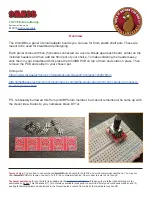
60
Maintenance
7.8.2 Cleaning the Submerged Area/Velocity Sensor (Oil-filled and Non-oil)
Important Note:
DO NOT interchange an oil-filled protective cover plate with a non-oil
cover plate. This adversely affects level readings. It is possible to convert one type of
sensor to the other using the Oil Probe Conversion Kit (Cat. No. 7730000), refer to the Oil
Probe Conversion Kit Instruction Sheet, Cat. No. 7730089 for more information.
Important Note:
When cleaning the transducer, use the most gentle technique possible.
Do not use sharp or pointed object to remove sediment from the face of the transducer. If
the transducer is nicked or dented, it breaks!
1.
Soak the sensor in soapy water
Note:
Do not soak the sensor in bleach. Bleach permanently damages the sensor. Refer to
for acceptable cleaning solutions.
2.
Remove the screws from the protective cover (
and
3.
Remove the cover and gasket.
4.
Swirl the sensor carefully in an appropriate cleaning solution to remove soil. Use a
spray or squeeze bottle to wash away heavier deposits.
5.
Clean the gasket and the cover. Replace the gasket (Cat. No. 7722000) if it is torn or
damaged. Level readings are adversely affected if the gasket is damaged or not
installed.
6.
Reattach the gasket and the cover (note orientation in
the screws until the gasket starts to compress.
7.
If using an oil-filled sensor, continue to follow the procedure mentioned in
Table 11 Cleaning Solutions
Acceptable
Unacceptable
Dish Detergent and Water
Concentrated Bleach
Window Cleaner
Kerosene
Isopropyl Alcohol
Gasoline
Dilute Acids
Aromatic Hydrocarbons
Summary of Contents for 911
Page 2: ......
Page 14: ...12 General Information...
Page 16: ...14 Getting Started...
Page 42: ...40 Meter Installation...
Page 44: ...42 Software and Communications...
Page 58: ...56 Sensor Installation...
Page 68: ...66 Maintenance...
Page 72: ...70 Replacement Parts and Accessories...
Page 76: ...74...
Page 88: ...86 Channel Installation Options...
Page 92: ...90 Batteries and Chargers...
















































